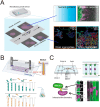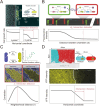Microfluidic approaches in microbial ecology
- PMID: 38344937
- PMCID: PMC10898419
- DOI: 10.1039/d3lc00784g
Microfluidic approaches in microbial ecology
Abstract
Microbial life is at the heart of many diverse environments and regulates most natural processes, from the functioning of animal organs to the cycling of global carbon. Yet, the study of microbial ecology is often limited by challenges in visualizing microbial processes and replicating the environmental conditions under which they unfold. Microfluidics operates at the characteristic scale at which microorganisms live and perform their functions, thus allowing for the observation and quantification of behaviors such as growth, motility, and responses to external cues, often with greater detail than classical techniques. By enabling a high degree of control in space and time of environmental conditions such as nutrient gradients, pH levels, and fluid flow patterns, microfluidics further provides the opportunity to study microbial processes in conditions that mimic the natural settings harboring microbial life. In this review, we describe how recent applications of microfluidic systems to microbial ecology have enriched our understanding of microbial life and microbial communities. We highlight discoveries enabled by microfluidic approaches ranging from single-cell behaviors to the functioning of multi-cellular communities, and we indicate potential future opportunities to use microfluidics to further advance our understanding of microbial processes and their implications.
Conflict of interest statement
The authors declare no conflicts of interest.
Figures





References
-
- Tinta T. Vojvoda J. Mozeticč P. Talaber I. Vodopivec M. Malfatti F. Turk V. Bacterial community shift is induced by dynamic environmental parameters in a changing coastal ecosystem (northern Adriatic, northeastern Mediterranean Sea) – a 2-year time-series study. Environ. Microbiol. 2014;17(10):3581–3596. doi: 10.1111/1462-2920.12519. - DOI - PubMed
Publication types
MeSH terms
LinkOut - more resources
Full Text Sources

